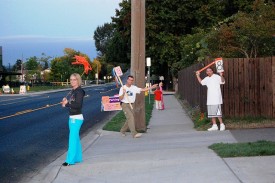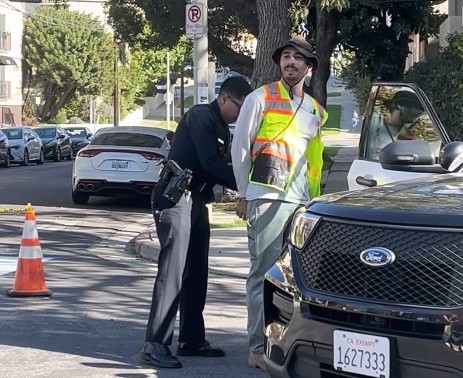This post is the 17th and final post in the series: Parking? Lots! Alan Durning is the executive director of the Sightline Institute.
Parking reform may finally be coming. Here are eight reasons to hope for change soon:
Noah’s (P)ark. UCLA planning professor Donald Shoup, like a modern day Noah, has been carrying a new strategy for parking reform far and wide looking for dry land on which to release it. The three-step plan of action — charging market prices for curb spaces through performance pricing, rebating the proceeds to neighborhoods, and then eliminating off-street quotas—is now working in several cities: Old Pasadena and San Diego, for starters. Parts of it are working many other places: Austin, Redwood City, Ventura, San Francisco, Washington, DC, and the Northwest’s big cities, too. Each success breeds more, as localities copy good solutions from each other.
Jurassic Park? Curb parking has long been an archaic, hunter-gatherer world with spotty enforcement and widespread cheating. But new technologies are dragging public parking out of prehistoric times and into the modern era. Smart parking meters, in-street sensors, parking-enforcement tools such as license-plate scanners, and apps for finding and paying for parking have opened up new possibilities for managing parking on the street. Cities can collect for and enforce parking charges even on quiet streets, and parkers can locate spots efficiently. All of this makes it much easier to charge for curb parking.
Spot Me. The same info-tech tools are making it possible for people to rent out their own parking spaces — a vast, distributed private market for parking spots. Dozens of new apps like Parkatmyhouse and Parkopedia are turning idle spaces into cash, allowing much fuller use of them and inverting their owners’ political motives. Owners of off-street spaces lose out from free on-street spaces and mandatory off-street spaces nearby. As parking space micro-entrepreneurs grow in numbers, and as they find their political voice, they will counteract parking territoriality.

Park’s Peak. As Clark Williams-Derry has pounded into our heads, driving and car ownership per person have long since peaked. Car-free and car-lite lifestyles are surging. In Seattle, 16 percent of households do not have private vehicles. In central Vancouver, BC, that number rises to 26 percent, and in greater Vancouver overall, 10 percent of households do not own cars. The new reality of dipping motorization is shaking conventional assumptions and arming critics of high parking quotas with new arguments.
Spot Check. Counting empty spaces seems elementary, but it’s only now becoming normal. King County’s Right-Size Parking project, for example, counted parked cars in the middle of the night at 200 apartment and condo buildings in and around Seattle, and it raised the data bar for parking studies off the ground, finally. Parking quotas have long been set based on groupthink and pathetically inadequate data. RSP shows that, at least in multifamily buildings, quotas radically overshoot actual parking. A similar study in Vancouver, BC, found the same thing. Such studies allow planners and developers to make the case against quotas, and they show others that checking spots is a good way to fight parking mandates.
Parker Brothers. Car-sharing — the modern-day version of a universal brother- (and sister-) hood ethos — is thriving in Portland, Seattle, and Vancouver, BC. Fleet-based companies Zipcar and Car2Go are strong in all three cities. Modo, the pioneering car-sharing coop, continues a vibrant service in Vancouver. Peer-to-peer company RelayRides, through which people rent cars to each other by the hour, operates nationwide in the United States, and its main rival Getaround has a big presence in Portland. Getaround now has more vehicles registered in the Rose City than all other car-sharing services combined.
Car-sharing has massive implications for parking. In greater Vancouver, BC, typical apartment-dwelling households that belong to a car-sharing service own 0.8 cars apiece, while similar non-car-sharing households own 1.3 cars apiece. One North American review of car-sharing’s parking consequences concluded that each nearby car-sharing vehicle obviates the need for four to eight parking spaces at an apartment building (see page 10).
Car-sharing still has ample room to grow; in Vancouver, BC, just 16 percent of surveyed apartment-dwelling households have a car-sharing membership. As the brotherhood of car-sharing grows, furthermore, the benefits of joining grow. If your town has 1,000 cars of which five are shared, you will not always be able to get one. But if your town has 300 private cars and 200 shared cars, you’ll always be in luck. And your town will need half as much parking.
So as car-sharing spreads, it will keep reducing both car ownership and, especially, parking demand.
Passenger Load Only. Car-sharing, what’s more, is just one dimension of the sharing economy’s parking impacts. Ride-sharing, in which people rent out empty spaces in their moving cars (rather than renting out the cars themselves), is exploding in Seattle and may take off elsewhere soon. Where it is robust, it makes car ownership — and parking — less necessary for many people. Exemplified by companies like UberX, Lyft, and Sidecar, which turn private cars into part-time taxis, ride-sharing could eventually grow into a massive, real-time market for individual rides -- more like instantaneous, ubiquitous carpooling than taxi service. Considering that the typical moving car has four unused seat belts, its growth could eviscerate parking demand. It could double the occupancy of typical cars, for example, and halve the number of parked cars at many destinations.
See Spot, Run. The high-tech/venture-capital mavens of our world are now predicting the near-disappearance of the private car. They foresee self-driving taxis delivering themselves to customers, ferrying them to destinations, and scurrying along to pick up other customers. They’ll (robotically) see parking spots but just keep running to their next appointment.
A typical car sits idle 23 hours a day (see page 624), and it needs a parking stall to sit idle in. The current vehicle fleet is massively overbuilt. With a vehicle fleet that’s a tiny fraction as large but usually in motion, few vehicles will be parked at any given time. This future may be 25 years away still, but the buildings we’re constructing now may spend most of their lives in that public-car world, not in our private-car world. Even the chance of this future is an argument against high parking quotas.
These eight factors all augur well for parking reform. The Shoup plan is inverting parking politics where it’s taking hold, block by block and neighborhood by neighborhood. Technology is modernizing and marketizing car storage, and better surveys are revealing the excesses of existing quotas. Why insist on lots of off-street parking if private car ownership is slipping, car-sharing (from Zipcar to Getaround) and ride-sharing (from Uber to Sidecar) are surging, and there’s a chance self-driving, self-delivering Car2Googles will make private cars a rarity within the lifetime of all buildings under construction?
Between them, these forces could reform parking much sooner than most observers expect and deliver us the abundant benefits it promises, such as more-elegant streetscapes, safer travel, more-affordable housing, less carbon pollution, and indescribably giant cash savings.








